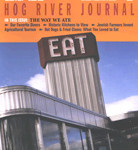(c) Connecticut Explored Inc. Spring 2006
Subscribe/Buy the Issue!
Food, glorious food. We’ve become such a nation of “foodies,” it seemed natural for HRJ to celebrate Connecticut’s culinary past. We dove into the theme with relish (my last food pun, promise), discovering food historians and learning a new academic term for this area of study: historic foodways. But I, for one, was skeptical about getting too nostalgic. To be honest, who among us isn’t eternally grateful for being liberated from our mother’s cooking by the wonderful infusion and availability of ethnic foods in Connecticut in the last 25 years, not to mention the more recent emphasis on “fresh” and “locally grown” ingredients?
Well, not so fast. As our readers tell us, the foods and restaurants of our childhoods have a tight grip on our hearts and stomachs. Fried seafood and hot dogs, the latter especially fully loaded with condiments, figure prominently in our special feature this issue, “What We Loved to Eat,” on page 46. Just the other night, a childhood favorite of mine, scalloped potatoes and ham, made a rare appearance on our dinner table. Perhaps because I so rarely eat potatoes anymore (thank you, Dr. Atkins), it tasted out of this world.
Many of us grew up with a strong ethnic flavor in our home-cooked meals. My grandparents emigrated from Sweden in the 1920s, so the Swedish foods of my childhood are near and dear to my heart. My family continues to hold a traditional Swedish Christmas Eve smorgasbord: with everything pickled, pressed, jellied, or heavily salted, though, my mother (who married into this tradition) once wryly observed, “Whatever did the Swedes do with the good part of the pig?” When my parents visited relatives in Sweden not long ago, offering as a hostess gift some Vermont maple syrup to have with their hosts’ traditional Swedish pancakes (think French crepes), they discovered our Swedish relatives don’t eat pancakes for breakfast, they eat them for lunch—with pea soup, and traditionally on Thursdays! I expect the migration of the pancakes from lunch to breakfast was an American adaptation on my grandmother’s part.
In this issue we look at our state’s food history from a variety of angles: where we ate (see “Lunch Wagon to Space-Age Diner“); what we grew (see “Suffield: A Town of Farms” and “Hebrew Tillers of the Soil“); and how we cooked our food (see “Can We See the Kitchen?” and “Native American Cuisine Saves the Colonists“). Editor Jennifer LaRue Huget reports on the first American cookbook, published right here in Connecticut in 1796 by Amelia Simmons. Our Destination is the Connecticut River Museum’s annual Shad Festival—a Connecticut tradition if there ever was one. Finally, Susan Chandler links the past to the present with a Soapbox on the virtue of heirloom foods and the Slow Food Movement.
NEW! With this issue we’re also introducing a new benefit for our subscribers: up-close-and-personal
tours that offer readers a unique opportunity to experience some of the stories in HRJ with the people who wrote them. One trip is offered this spring, and a second is planned for the summer: a half-day historic-kitchen tour with Melanie Anderson Bourbeau, author of this issue’s “Can We See the Kitchen?,” and a day in Old Lyme to tour the newly restored Florence Griswold Museum with Liz Farrow, author of “The Spirit of Miss Florence Restored” from the Winter 2005/2006 issue. We are grateful to Hill-Stead Museum and the Antiquarian & Landmarks Society for their partnership in planning these trips. For more details on how to reserve your spot, see Letters, Etc., on page 10.
Bon Appetit!
Explore!
Read all of the stories from the Spring 2006 issue
Read all of our stories about Food & Drink history on our TOPICS page

